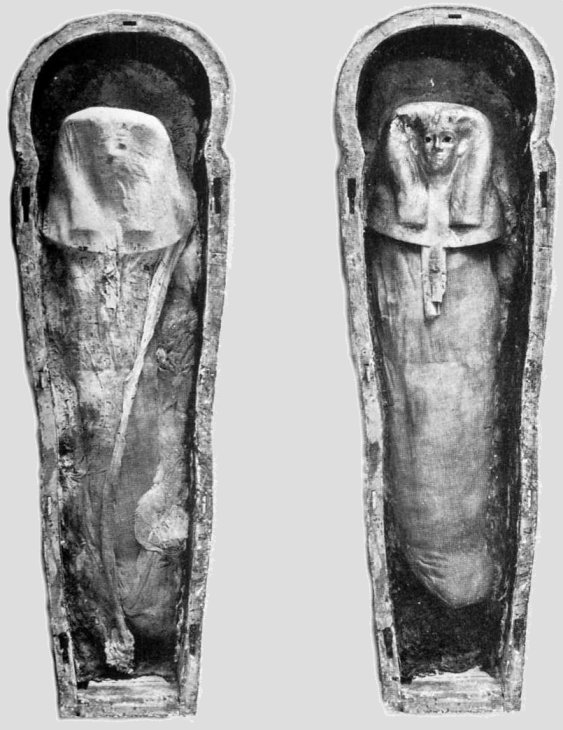 |
Senenmut |
last update:
12.12.2006
|
|
The debris used to build the forecourt of TT71 had also covered the tomb of
the parents of Senenmut,
Ramose and Hatnefret. This tomb was discovered by A. Lansing and W. Hayes in
1936 during the work below the forecourt
of TT71. Hidden under the terrace of
TT71 the tomb stayed undiscovered till modern times and untouched.
Therefore, the tomb not only has a special importance within the
discussion about accession o f Hatshepsut to the throne, but it also
belongs to the few tombs from the 18th dynasty which have been preserved
intact (Smith, 1992).
|
|
At first, a rectangular tambourine was found in front of the blocked
entrance of the tomb. Presumably, the tambourine which probably had belonged to
Hatnefret was most likely used during the burial, "killed ritually" - the rawhide cover had been
smashed - afterwards and put down in front of the entrance to the tomb. Into the inside of the tambourine the components of a chair (see
below) had been thrust. Beside the tambourine the upper part of a cedar
headrest was found.
|
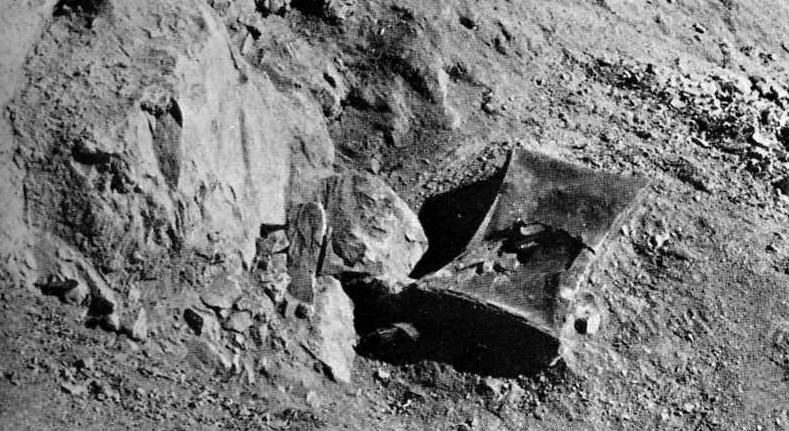
| The tambourine (above) which was found at the blocked entrance
to the tomb and below the restored chair found inside the tambourine
(photos by Burton, from Hayes, BMMA, 1937). The chair had a well-preserved seat of
cord mesh, Lion- legs, and a paneled back composed of a figure of the god Bes flanked on either sides by Djed pillars and Ankh-signs. |
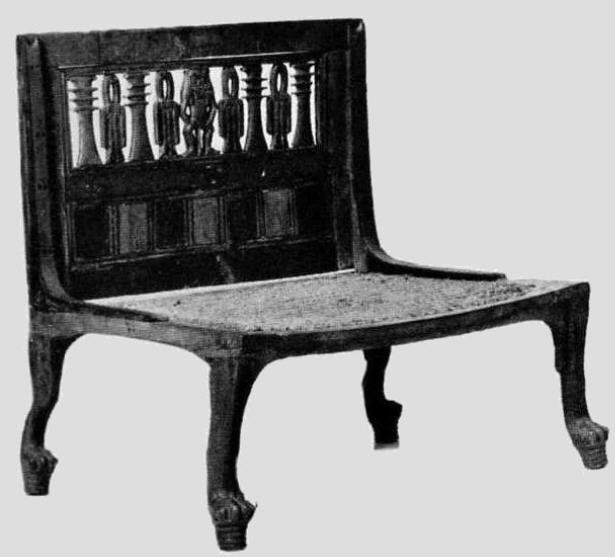
|
The tomb was closed by a slab of stone which was held in position and
covered with rough white mortar. After removing the blocking a tiny
rectangular passageway appeared. The passageway was lined with rough
limestone jambs and led in a small rock-cut chamber, 1.3 m in height, 2.5 m
deep, and 2.9 m wide.
|

|
The view through the doorway into the tomb of Ramose and Hatnefret when
first opened (photo by Burton, from Hayes, BMMA. 1937)
|
|
After removal of the blocking the first glance the eyes were confronted
with an white, uninscribed canopic chest (no. D in the drawing below) which had been
mounted on sledge runners (see photo below; photo from Hayes, BMMA, 1937) and beside and behind it a mass of coffins,
all of them covered by palls, and boxes.
|
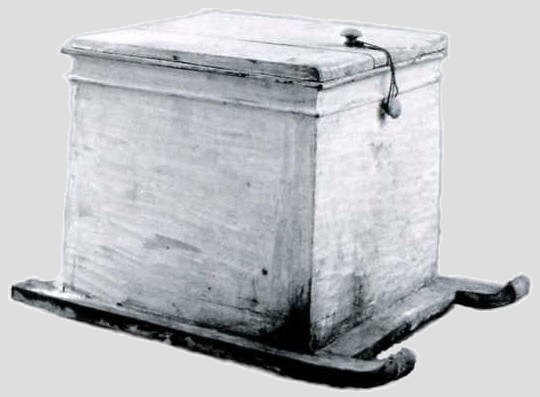
|
Above the canopic chest of Hatnefret; under the lid wooden
"doors" were discovered which could be locked. The doors covered
the 4 chambers of the canopic chest (photo below). The 4 canopic jars in
the chambers are of pottery, three were closed with a stopper each of
which carried a human head. The 4th jar carried a stopper with a canine
head (Dua-mut- ef). All 4 jars were uninscribed.
|
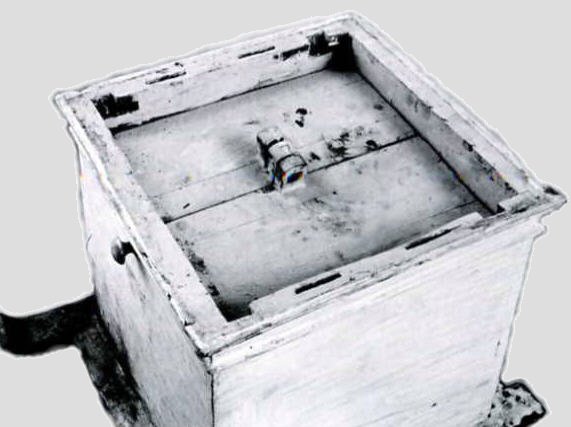
|
The following drawing (taken from Hayes, BMMA, 1937) shows that the small
tomb had been completely filled with coffins and funeral equipments.
|
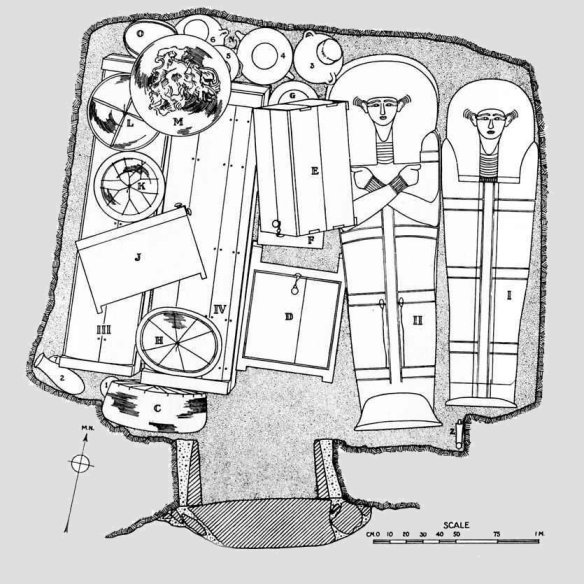
|
I
|
-
|
white anthropoid coffin of Ramose (no title is mentioned on the coffin)
|
|
II
|
-
|
black anthropoid coffin of the "Mistress of the House, Hatnefret"
|
|
II
|
-
|
rectangular coffin
|
|
IV
|
-
|
rectangular
coffin
|
|
C
|
-
|
basket with bread, dates, raisins
|
|
D
|
-
|
canopic chest of Hatnefret
|
|
E
|
-
|
box with linen
|
|
F
|
-
|
box with linen
|
|
G
|
-
|
alabaster jar (uninscribed)
|
|
H
|
-
|
basket (remains of mummy wrappings)
|
|
J
|
-
|
box
|
|
K
|
-
|
basket with linen
|
|
L
|
-
|
basket with linen and among others 3 vessels made of silver
|
|
M
|
-
|
basket with linen
|
|
N
|
-
|
alabaster jar, with a shot column of hieroglyphic inscription giving the
name "Hatshepsut" and her early titles as queen
|
|
|
|
|
The positions of the coffins and the burial objects admits the
conclusion, that
1. all burials had taken place at same time;
2. that the coffins were brought into the tomb in the order: Ramose, Hatnefret, coffin III, and, in
the end, coffin IV,
3. that the burial objects have been brought last into the tomb, and
4. the fact that all burial objects presumably belonged to the burial of Hatnefret
(since there no doubles).
|
The white painted, anthropoid coffin of Ramose was of mediocre quality
enriched a little bit by the gold foil with which face, throat and ears had
been covered. This coffin was opened first, however,
it contained only the disjoined bones. The inspection of the bones revealed
that Ramose was a short, lightly built man who was fairly advanced in years when he died.
Two of the bandages with which once
his body had been wrapped were marked in ink with the cartouche of Neferu-Ra,
daughter of the Hatschepsut and Thutmosis II. In the coffin and in the tomb
there were no burial objects which could be attributed to Ramose -
he obviously has had not only no important title (i.e. no important office), he
apparently has been also a "poor" man (see also note of the
author at the end of the page).
|
|
From all coffins in the tomb that of Hatnefret was the most precious one.
The lid of the mummiform coffin (see below; from Hayes, BMMA, 1937) with the arms
crossed about the chest, holding a papyrus flower in every hand, was
worked carefully and painted black inside and outside. Face and throat
were covered with gold foil, the eyes, inlaid in ebony, were made of
alabaster and obsidian. Multicolored figures of Nephthys and the Isis
decorated, in addition, the ends of the coffin.
|
|
A total of 8 linen shawls or sheets surrounded the mummy of Hatnefret (see
above, central photo), either they lay stretched out on the mummy or
they had been rolled up and packed into the coffin all around the mummy.
All the ledges of the linen were stuck fast in the walls of the coffin. Two of the linen shawls carried in black ink and in cursive hieroglyphics
the inscription "Good Goddess, Maat-ka- Ra, loved by Amun, she may
lives for ever. "
|
|
After removing the outer shroud (above, center) on which with black and
red ink the spells 72 and 17 from the Book of the Dead were written a
gilded funerary mask appeared (above, right). The mask consisted of coarse
linen which were coated inside and outside with white stucco. The eyes had
been inserted in the stucco and then the mask had been covered with gold
foil. On the chest of the mummy there lay a tied up bundle (above,
right) that contained two papyrus rolls and a roll of leather. Due to
their critical condition the papyrus rolls were not opened, nevertheless,
with the help of the outer inscription the larger roll was identified as a
part of the Book of the Dead, the smaller one is presumably a part of the
Amduat. The roll of leather was examined in Cairo and carried Chapter 100
of the Book of the Dead.
|
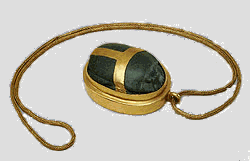
|
Outside on the mummy, but covered by the mask, lay a heart scarab of green
stone set in gold (above; today in the Metropolitan museum of Fine Arts,
New York). Nearby, on the right shoulder, lay a small silver pocket mirror
(length <12 cm).
|
|
Left hand and left wrist of Hatnefret glittered in the shine of signet
rings and scarabs which were enclosed in gold and silver. A fine
blue scarab which had been tied with a band to the thumb of the left hand
carried the name of Hatschepsut and the title "God's Wife" - the
title of Hatschepsut as crown princess and as the queen of Thutmosis
II.
|
|
The mummy of Hatnefret was well preserved. She was an old lady at the time
of her death, short and delicately boned but distinctly fat. Her own
sparse and gray hair had been covered by a large wig made of linen and black
human hair (see below; photo from Hayes, BMMA, 1937)
|
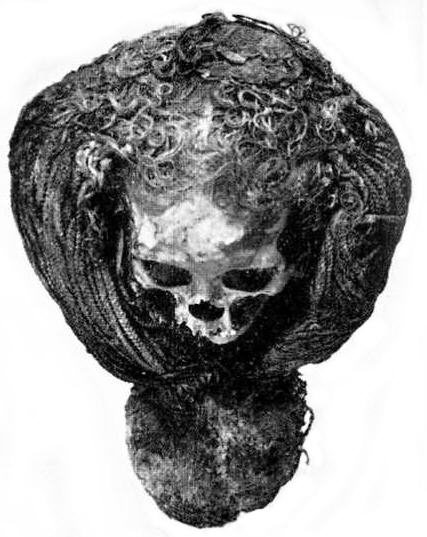
|
As already mentioned above, Hayes and Lansing have assigned all funerary
objects to Hatnefret, although no object carried a name. In their opinion
all objects belonged together and only to one person, because no duplicates
were found. Indeed, there were 7 baskets, 3 boxes, 3 alabaster vessels, 7
pottery vessels, 6 pottery dishes, but these could come from the
possession of only one person because there was only one canopic chest,
only one mirror, only one razor, only one pair of sandals, only one kohl
jar and stick, only one pillow, only one set of silver vessels, and only
one bead necklace.
|
Several alabaster and potteries vessels turned out to be of special
interest. While the alabaster vessel with the name G (see plan above) was
uninscribed, the alabaster vessel N carried the name Hatshepsut and her
early titles as queen.
The three big pottery amphorae 3, 4, and 6 which
had been put down along the north wall of the tomb carried large mud seals
with oval stamp impressions and ink inscriptions on the sides. Nine of the
stamp impressions showed the name of Hatschepsut and her titles as a royal
wife, but 4 her titles and her names as a king.
The ink inscriptions on
the sides mentioned different oils as content of the jars whereby the
inscription on jar no. 4 contained the information "Year 7 of
Thutmosis III" as a date. Also pottery jar no. 5 carried as a
date year 7 accompanied by the designation of the month, the day, and the
contents of the vessel.
|
|
The other two coffins which were put down on the left side of the
chamber were of simple design - rectangular boxes made of pine boards,
with vaulted lids and ending with upwards projecting boards at the small
sides. They were less than
1.90 m in length and unpainted.
|
|
The burials in the coffins were as poor as the coffins themselves. In
coffin III two young women and 2 small children had been buried whereby
one child had been wrapped together with one of the women. Coffin IV
contained the bandaged skeletons of another woman and an infant child. The
bodies of the deceased had been treated with even less care than that of
Ramose, obviously without further treatment they had been wrapped in
shrouds and had been bandaged.
|
|
Little of interest was discovered on the persons, mostly bracelets of
beads made of different materials (faience, glass, stone, silver),
as well as scarabs which were worn as a rings. Some of the scarabs were of
good quality, among them one with name and title of Hatschepsut as a royal
wife and another, with name and title of her mother, the "Great Royal
Wife (of Thutmosis I), Ahmose".
|
|
Neither the coffins nor the burial objects contained the names of the
deceased. Hence, not only the identity of these three women and three
children but also their relation with the household and with the family of
Senenmut remains unsolved. The fact that they were buried together but
also the burial objects with the royal names, prove that these persons had
been contemporaries of Ramose and Hatnefret (and Senenmut). These are not
intrusive burials, particularly as also the location of the tomb has
excluded later burials.
|
|
It appears extraordinary that so many persons of a family or a group have
had died possibly at the same time, so that they could be buried
together.
|
Note of the author:
Hayes made in the cited publication (BMMA, 1937) the following
statement about Ramose:
"He was therefore a commoner, probably a peasant, for at this time
anyone engaged in the learned professions or associated with the state or
religious administration could always summon up a title of some sort
...."
This statement of Hayes probably reflects the "American Dream"
but it seems rather unlikely that the Ramose had been a peasant. If one
compares the burial of the parents of Senenmut with those of
contemporaries (e.g. the family of
Neferkhaut, Satnem and Ibentina),
one must draw on the basis of comparable tombs and burial objects the
conclusion that Ramose certainly had not been a significant figures at the
royal court or its milieu, but rather had been a lower official or
craftsman.
|
|







